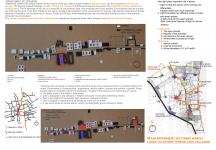Fatehpur has an extraordinary long and varied history, but the urban fabric of the old city is threatened by overloading, lack of maintenance and poor services. The revitalization of Shekhawati region aims to rehabilitate the city, to preserve its heritage and create a better quality of life for its inhabitants.
It is a comprehensive project aimed at every aspect of human life, with several components, including restoration, training, education and raising public awareness. All these components are tied together to achieve an integrated enduring revitalization.
The urban fabric has suffered from neglect, inappropriate use and inadequate services, with many people living in dilapidated buildings in unsanitary conditions. The centre will and is composed of professionals from different fields namely architecture, engineering, planning, economics and history. Its main aim is to implement a comprehensive program for the rehabilitation of the town, comprising a number of complementary components, a revitalization plan, emergency restoration, total restoration, training in conservation, a community outreach program and an information centre.
Revitalization plan forms the basis of programs work.
A survey was carried out to identify the buildings which come under heritage rules and are in danger.
The areas of the program complement the restoration work to ensure the sustainability of the improvements. Training for architects, engineers, contractors and crafts people is provided through short courses, internships and fellowships to study. professionals and organizations.
2009
A community outreach program encourages public awareness and participation in the rehabilitation process and organizes publications, meetings, workshops, residents and users. Further components of the program are proposed: an information and cultural centre and a data bank of conservationist
1. Welcoming the visitors to the area
2. Orienting the visitors(letting them know what they can see and do in this area, with the help of maps, brochures and interpretative activities.
3. sensitizing the visitors to the area values (displaying information which explains the reason the area exists, how and what they can learn from here, how they can protect and conserve the area)
4. Responding to the visitors: providing good facilities and amenities for the public along with lot of open and semi open public areas.
5. Interpreting the site: giving brochures, putting up photographic panels, models which will help them understand better.
Abuzar Plasterwala









